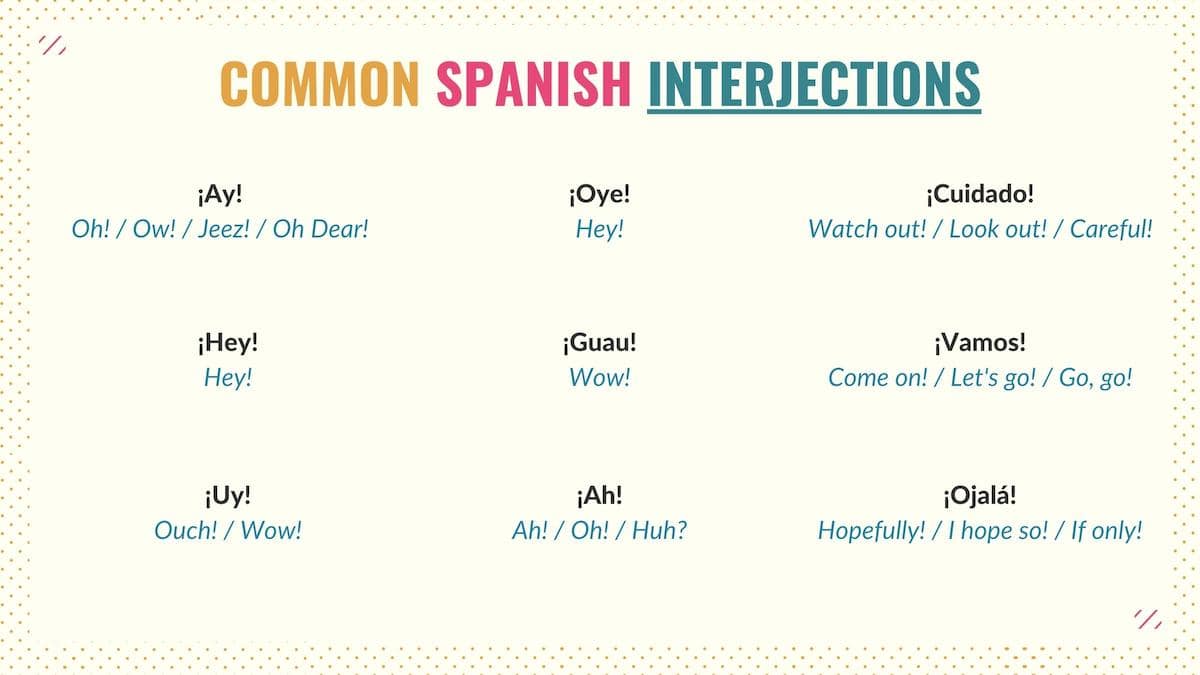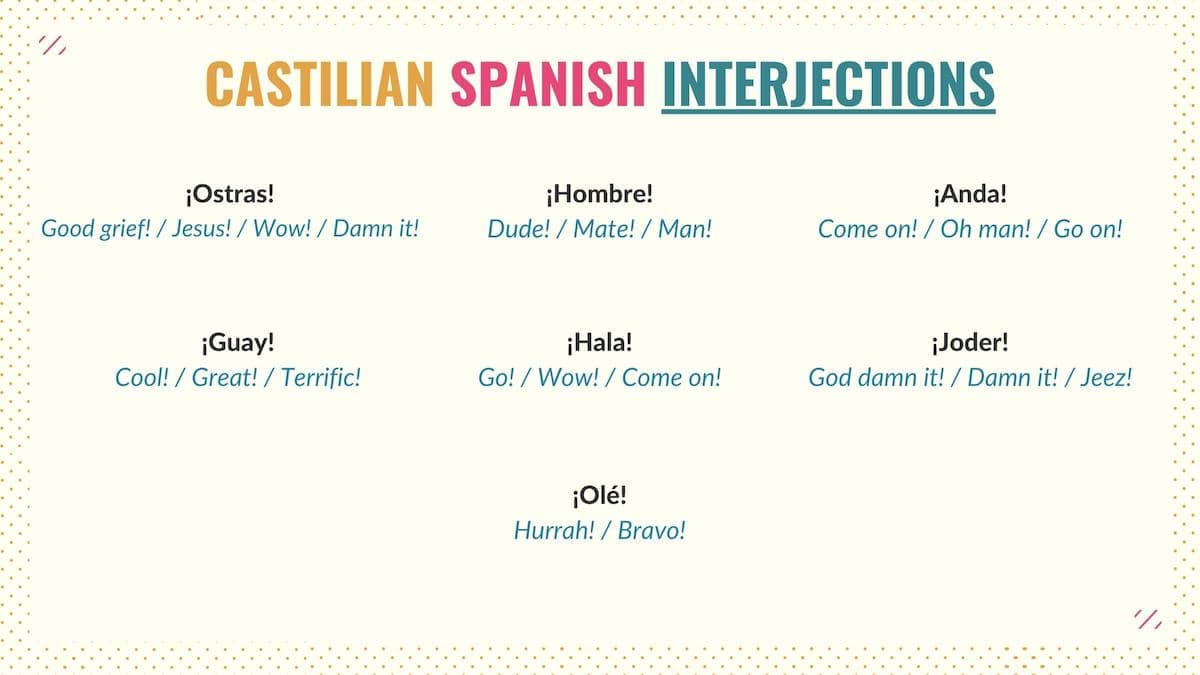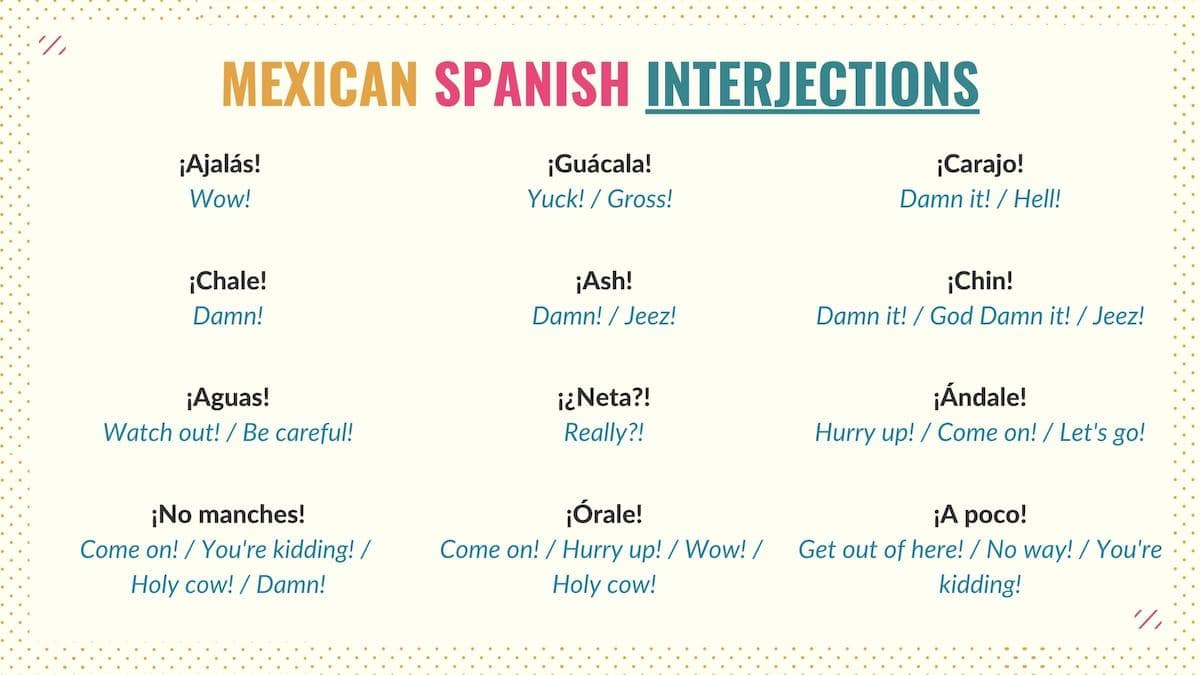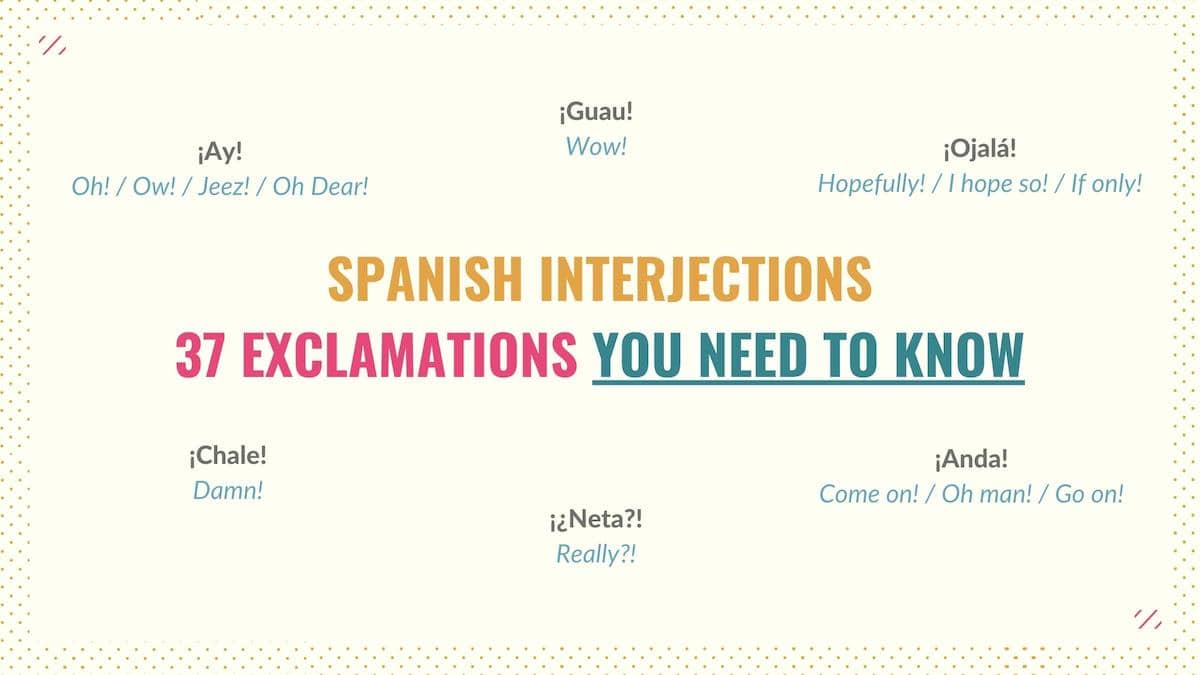Spanish interjections (also called exclamations) are words and phrases we use to express a feeling or catch someone’s attention. In a nutshell, exclamations in Spanish are common elements in day-to-day conversations.
So, in this guide, I’ve compiled 37 common Spanish interjections and exclamations you should know. Here is how this list is broken down:
Take Note: Interjections are a part of speech in Spanish, meaning that they’re essential to form sentences.
Common Spanish Interjections
Below is a list of common interjections in Spanish that can be used to express a different range of emotions. Your tone of voice is crucial to convey your feelings!

1. ¡Ay!
Ay is one of the most common and rich interjections in Spanish. Ay can express surprise, anger, frustration, or pain. Depending on how it’s used, it means ‘ow’, ‘jeez’, ‘oh’, or ‘oh dear’.
¡Ay! No es para tanto.
Jeez! It’s not a big deal.
¡Ay! ¡Algo me picó!
Ow! Something stung me!
2. ¡Oye / Oiga!
Oye and oiga (formal you) mean ‘hey’. These Spanish exclamations are exclusively used to call someone and catch their attention. They’re never used as a word to greet people.
¡Oye! Se te cayó tu cartera.
Hey! You dropped your wallet.
¡Oiga! ¿Sabe dónde está la parada?
Hey! Do you know where the bus stops?
Take Note: Generally, Spanish interjections are invariable words like ay. However, a few interjections are derived from verbs. Those types of interjections may change to address the person you’re trying to call correctly.
3. ¡Cuidado!
To warn someone to be careful or watch out for an upcoming threat, we use the Spanish interjection ¡cuidado! This expression means ‘watch out’, ‘look out’, or ‘careful’.
¡Cuidado! El vaso se va a caer.
Watch out! The glass is falling.
4. ¡Hey!
Hey or ey are the equivalents of the interjection ‘hey’. Use these expressions to greet someone or try to catch their attention.
¡Hey! ¿Cómo andan?
Hey! How are you, guys?
5. ¡Guau!
¡Guau! is a common exclamation of amazement in Spanish. It’s the equivalent of ‘wow’.
¡Guau! ¡Qué bonita casa!
Wow! What a pretty house!
Take Note: When talking about dogs or animals, ‘guau’ can be used to represent the sound of barking. You can learn more vocabulary related to animals in Spanish here.
6. ¡Vamos!
The Spanish interjection ¡vamos! is used to hurry someone up or to encourage people during a game or activity. This exclamation means “come on”, “go, go” or “let’s go”.
¡Vamos! Se nos va a hacer tarde.
Come on! We’re going to be late.
7. ¡Uy!
Depending on how it’s used, ¡uy! can be an exclamation of surprise, pain, or displeasure. It’s close in meaning to ‘ouch’ or ‘wow’.
¡Uy! La comida está carísima.
Wow! The food is so expensive.
8. ¡Ah!
¡Ah! is an interjection that conveys surprise, disbelief, or sorrow. You can also use it as a question to tell someone else you didn’t understand or hear something. ¡Ah! means ‘huh?’, ‘ah’, or ‘oh’.
¡Ah! ¿En serio te dijo eso?
Oh! Did he really say that?
9. ¡Ojalá!
The Spanish interjection ‘¡ojalá!’ is used to express desires. In this context, it means ‘if only’ or ‘I hope so’.
| Spanish | English |
|---|---|
| Te va a ir bien en tu trabajo. | You’re going to do fine at your job. |
| ¡Ojalá! | I hope so. |
Pay attention to the context because ojalá can also be used by a group of people, in which case it would mean ‘we hope so’.
10. ¡Eh!
In Spanish, eh is an interjection we can use to catch someone’s attention. If it’s in the interrogative form, it can express that you didn’t hear what someone said or may request confirmation about something you asked someone to do. ¡Eh! means ‘hey’, ‘huh?’ or ‘okay?’.
¡Eh! ¡Ese teléfono es mío!
Hey! That phone is mine!
Me hablas cuando llegues, ¿eh?
Call me when you arrive, okay?
11. ¡Basta!
¡Basta! is an informal interjection you can use to ask someone to stop doing something. It means ‘enough’ or ‘that’s enough’. ‘Basta ya’ or ‘ya basta’ are similar Spanish expressions you can use.
¡Basta! No quiero escuchar otra palabra.
Enough! I don’t want to hear another word.
12. ¡Ups!
In Spanish, ¡ups! is the interjection we use after making a mistake or having a small accident. It means ‘whoops’ or ‘oops’.
| Spanish | English |
|---|---|
| ¡Hey! ¡Ese era mi vaso! | Hey! That was my cup! |
| ¡Ups! | Whoops! |
13. ¡Ajá!
The Spanish interjection ¡ajá! expresses surprise or agreement. It means ‘aha’, ‘uh-uh’, or ‘great’.
¡Ajá! ¡Ya encontré tu celular!
Aha! I found your phone.
Ajá can also be used in the middle of a conversation as filler words to show people you’re listening to them.
14. ¡Menos mal!
In Spanish, ¡menos mal! conveys relief when something bad we thought would happen didn’t take place. This exclamation can be translated as ‘thank God’ or ‘luckily’.
¡Menos mal que pudiste entregar tu proyecto!
Thank God you were able to deliver your project!
15. ¡Maldita sea!
¡Maldita sea!, or its variation ¡maldición!, are exclamations you can use to express anger or frustration. They both mean ‘damn’ or ‘damn it’.
Voy a llegar tarde, ¡maldita sea!
Damn it! I’m going to be late.
16. ¡Qué bárbaro!
¡Qué bárbaro! is a Spanish exclamation of amazement and admiration. Since this interjection is directed at a man. You should use ¡qué bárbara! to address a woman or ¡qué barbaridad! when referring to a situation.
These expressions mean ‘wow’, ‘awesome’, ‘brilliant’ or ‘cool’.
¡Qué bárbaro! ¿Cómo le hiciste?
Wow! How did you do that?
Take Note: A few interjections in Spanish come from other parts of speech, such as adjectives and verbs. Since these are derivatives rather than pure interjections, we must follow the gender and pluralization rules of those words. ¡Qué bárbaro! and its variations are examples of this.
17. ¡Vaya!
¡Vaya! is an interjection you can use to express surprise or anger. Depending on the sentence, this exclamation can be translated as ‘well’, ‘damn’, or ‘oh boy’.
¡Vaya, vaya! ¡Qué milagro, Ángeles!
Well, well! Long time no see, Ángeles!
18. ¡Dios mío!
Dios mío is the direct translation of ‘oh my God’ or ‘my goodness’. So, this Spanish interjection is commonly used to express surprise or frustration.
¡Dios mío! Ya te expliqué tres veces.
Oh my God! I’ve explained this to you three times.
Check this article to learn other ways to say oh my God in Spanish.
Common Castilian Spanish Interjections
In this section, you’ll find some of the most common interjections used in Castilian Spanish.

19. ¡Ostras!
Use the expression ¡ostras! to convey anger, surprise, or frustration. This interjection is close in meaning to ‘good grief’, ‘Jesus’, ‘wow’, or ‘darn it’.
¡Ostras! ¡Las llaves!
Darn it! They keys!
20. ¡Hombre!
¡Hombre! is another interjection of amazement in Spanish. This expression is the equivalent of ‘dude’, ‘mate’, or ‘man’.
¡Hombre! Pero es que no es para tanto.
Dude! It’s not a big deal.
21. ¡Anda!
In Castilian Spanish, ¡anda! or its variation ¡anda ya! can express surprise or annoyance. It can also be used to urge someone to go or do something. They mean ‘come on’, ‘oh man’, or ‘go on’.
| Spanish | English |
|---|---|
| Ramón está de gerente en la oficina. | Ramón is the manager of the office. |
| ¡Anda ya! ¡Me estás tomando el pelo! | Come on! You’re messing with me! |
22. ¡Guay!
¡Guay! is a common interjection in Castilian Spanish that expresses surprise or approval. So, it means ‘cool’, ‘great’, or ‘terrific’.
| Spanish | English |
|---|---|
| Entonces, quedamos mañana a las 8. | So, tomorrow at 8. |
| ¡Guay! Nos vemos ahí. | Great! See you there. |
23. ¡Hala!
The Spanish interjection ¡hala! expresses amazement, but it can also be used to encourage people. It can be translated as ‘go’, ‘wow’, or ‘come on’.
¡Hala, Madrid!
Come on, Madrid!
24. ¡Joder!
¡Joder! is a coarse interjection that can convey annoyance or frustration. It’s close to ‘God damn it’, ‘jeez’, or ‘damn it’.
¡Joder! ¡Pero qué pesado eres!
Jeez! You’re so annoying!
25. ¡Olé!
¡Olé! is a positive interjection in Spanish. It expresses encouragement or appreciation for something well-done. It’s close in meaning to ‘hurrah’ or ‘bravo’.
¡Olé, chicos! Muy buen proyecto.
Bravo, guys! Very good project.
Mexican Spanish Interjections
Here are some common interjections in Mexican Spanish. Some of these exclamations may also be known in other Latin American Spanish-speaking countries.

26. ¡Ajalás!
In Mexico, ajalá or ajalás is an exclamation of amazement, so it’s close in meaning to ‘wow’.
¿Sí te dieron el puesto? ¡Ajalás!
Did you get the job? Wow!
27. ¡Guácala!
¡Guácala! is a Spanish interjection that expresses repugnance or nausea. It can be used to react to food, insects, or any disgusting things someone may do. It means ‘yuck’ or ‘gross’.
¡Guácala! ¿Qué es eso?
Gross! What is that?
28. ¡A poco!
¡A poco! is a Spanish expression of surprise and disbelief. Use it as a reaction to someone’s words. ‘¡A poco!’ is close in meaning to “get out of here”, “no way”, or “you’re kidding”.
| Spanish | English |
|---|---|
| Ayer corrieron a Sandy. | Yesterday, Sandy got fired. |
| ¡A poco! ¿Qué pasó? | No way! What happened? |
29. ¡Ash!
In Mexico, the Spanish interjection ¡ash! expresses impatience or frustration. So, it’s close in meaning to ‘jeez’ or ‘damn’. Be aware that some speakers may use it in a playful way.
¡Ash! Ahí viene la chica nueva.
Damn! The new girl is coming.
30. ¡Chale!
¡Chale! is an informal interjection in Spanish that expresses disappointment or resignation. It can be translated as ‘damn’.
¿En serio te vas a ir? ¡Chale!
Are you seriously leaving? Damn!
31. ¡Chin!
¡Chin! is a Spanish exclamation of surprise, annoyance or frustration. This interjection is close in meaning to ‘damn it’, ‘jeez’, or ‘god damn it’.
¡Chin! Se me olvidaron las llaves.
Damn it! I forgot my keys.
32. ¡¿Neta?!
Use the interjection ¡¿neta?! as an exclamation of amazement or disbelief. In this context, this Mexican slang word is close in meaning to ‘really?’.
| Spanish | English |
|---|---|
| Me voy a ir de vacaciones a Europa. | I’m going to Europe on vacation. |
| ¡¿Neta?! ¡Qué chido! Me mandas fotos. | Really?! That’s so cool! Send me pictures. |
33. ¡Aguas!
To express caution or warn people about an impending threat, Mexican speakers use the informal interjection ¡aguas!, which means ‘watch out’ or ‘be careful’.
¡Aguas con el perro!
Be careful with the dog!
34. ¡Ándale!
¡Ándale! is a common Spanish interjection to ask someone to hurry up or urge them to do something. This exclamation is the equivalent of “hurry up”, “come on” or “let’s go”.
¡Ándale! ¡Dame las llaves!
Come on! Give me my keys!
Take Note: Ándale is an interjection that derives from the verb andar. Like other interjections in Spanish that are formed from a verb, you can customize ándale to address different people.
35. ¡No manches!
¡No manches! is a Spanish interjection that can express surprise, anger, or frustration. It’s close in meaning to “come on”, “you’re kidding”, “holy cow”, or “damn”.
¡No manches! ¿Y luego qué pasó?
Holy cow! And then what happened?
36. ¡Órale!
In Mexican Spanish, ¡órale! is an exclamation of surprise, and it can also be used to tell people to hurry up. So, ‘órale’ means ‘come on’, ‘hurry up’, ‘wow’, or ‘holy cow’.
¡Órale! ¡No sabía que trabajaras aquí!
Wow! I didn’t know that you worked here!
37. ¡Carajo!
¡Carajo! is a common Spanish interjection that expresses a high degree of anger. It means ‘damn it’ or ‘hell’.
¡Así no se hace esto! ¡Carajo!
This is not how you do it! Damn it!
Take Note: There are other common cursing words in Spanish you can use as interjections of anger.
Download the PDF for Exclamations and Interjections in Spanish
Now that you’ve familiarized yourself with 37 of the most common interjections and exclamations in Standard Spanish as well as Castilian and Mexican Spanish, it can take time to memorize them and incorporate them in your daily conversations. Because of that, I’ve created a PDF with the full list that you can download for free.



